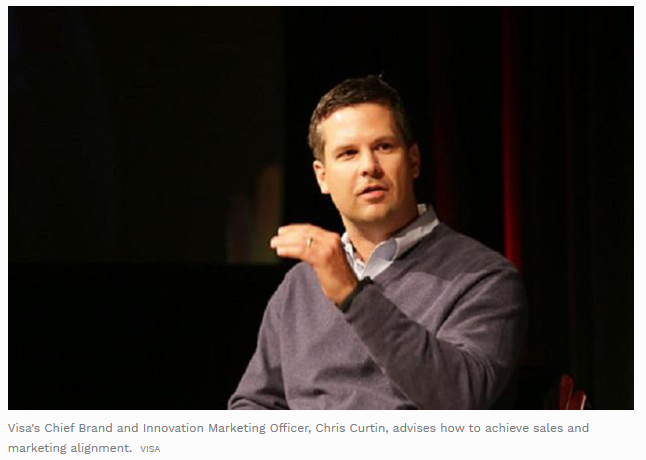Aligning sales and marketing is a top priority of CEOs, CMOs and sales leaders across businesses and enterprises and the impact of doing it poorly can be devastating to enterprise value. Doing it well leads to sustained success.
Visa, who will celebrate its 60th anniversary this year, is no stranger to success and the importance of sales and marketing alignment. Its VisaNet platform is the largest global payments network capable of handling a staggering 65,000 transaction messages a second and which offers solutions for a diverse group of customers including 3.3 billion card holders, 46 million merchants, and 16,000 financial institution clients. No wonder they appear at No. 27 on Forbes' World's Most Valuable Brands list.
Chris Curtin, Visa’s chief brand and innovation marketing officer, offered insights into how they approach sales and marketing alignment, as both a consumer and a business-to-business brand.
“The big unlock to aligning sales and marketing is to agree not just on the goals, but also the assumptions around those goals,” says Curtin. “Not just that we want to achieve the goals or that they are a nice to have, but truly digging into the how. You always need to ask ‘What would it take to hit that goal?’ That is the only way you know you really have a plan and not just wishful thinking.”
To avoid wishful thinking or false impressions of alignment, they utilize pre-mortems. These are meetings that you have “ahead of the action” of the campaign or annual plan to ask and answer the question “If we fail at our goal, why will we have failed?” Curtin recommends that leaders schedule a series of meetings asking questions like “What if you miss the target?” or “What if you hit the target, but it’s too late to impact the quarter?” This meeting is where you get all the worst case scenarios out on the table and have the functional experts to weigh in. “Ask the group to brainstorm all the reasons why a miss would occur,” Curtin continues. “Would it be because you’re missing the right sales materials, running the wrong promotions, setting the wrong price, missing a market window? Pretend you have a crystal ball.”
This forecasting allows you a chance to course correct before you leave the starting line heading in the wrong direction. “Post-mortems, or post-action reporting, don’t do you any good,” Curtain asserts. “You can’t change the view in the rearview mirror. But pre-mortems can change the future.”
These meetings have another advantage that gets to the heart of what often sabotages sales and marketing alignment and that is clean, clear communication across department or functional lines. “Post-mortems put people on the defensive,” Curtin observes. “They lend themselves to finger-pointing. Pre-mortems allow the staff to be more creative. To share the potential problems before they occur. Plans developed in isolation with the hope that they can reconcile after the fact never work.”
These meetings are serious business. Curtin warns that “if the pre-mortem isn’t tense and uncomfortable, you are doing it wrong. Either you’re not putting up all the risks, or your plan is too easy.” If you are to gain actionable insights, you need to get all the ideas on the table, no matter how uneasy they might make the team.
Once a list of possible misses and causes are identified, the team can do some probability analysis and conduct risk mitigation. This serves two purposes according to Curtin. First, “you can believe in your plan because you have identified the potential points of failure and are watching them more closely.” And secondly, “if things do slip [and you have done a pre-mortem], you already have language and a common understanding of what you are doing to do, together, across functions, to address.” All in all, this approach helps the team have the best chance of success at the start and throughout the year.
“It is not uncommon to find some tension (hopefully always constructive) between sales and marketing teams who are both competing for internal investment, resources and support as to which is the better ‘channel’ to utilize,” Curtain recognizes, informed throughout his career at Visa, HP, and The Walt Disney Company. “Incidentally, that tension can manifest itself within marketing – with the brand team and the direct response teams battling it out for budget,” Curtin continues. “The key to avoid this is to acknowledge that there is a ‘one team mentality’ and all the groups are driving towards a common outcome.”
Whether you are the market leader growing the category, like Visa, or a category creator of your own, Curtin offers some parting advice to those seeking better alignment. “The role of leadership is to find the right balance between and amongst the groups and to ensure that the process pulls out the best in teamwork.”
Scott Adams - the clever cartoonist behind Dilbert (who can boast of being the most photocopied, pinned-up, downloaded, and e-mailed comic strip in the world) and now author and investor - said, "Losers have goals, winners have systems." Pre-mortems can be part of your sales and marketing alignment system to achieve greater results, or at least greatly improve your odds.
This article originally ran in Forbes on July 16, 2018

